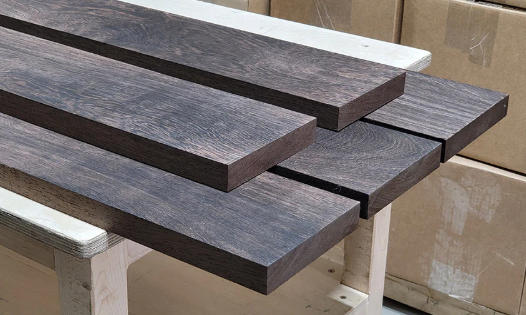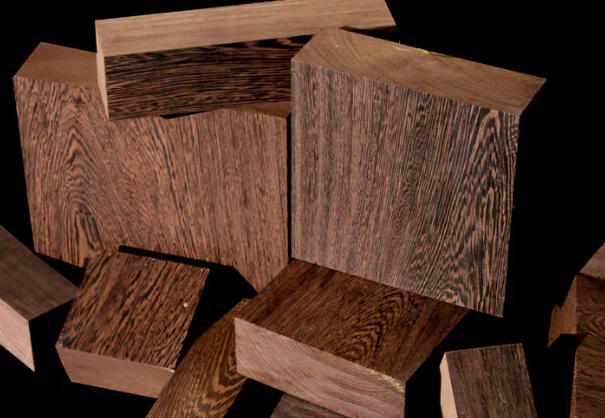










Content Menu
● The Ecology and Growth of Wenge Trees
>> Native Range and Ecological Role
● The Life Cycle Sustainability of Wenge Wood
>> Carbon Sequestration During Growth
>> Manufacturing and Usage Impacts
>> End-of-Life and Circular Economy Considerations
● Conservation Status and the Sustainability Paradox
>> Wildlife, Habitat Loss, and Illegal Logging
● Sustainable Forestry and Best Practices
>> Key Elements of Sustainable Forestry
>> Balancing Development and Conservation
● Applications and Industry Perspectives
>> Wenge Wood in Furniture and Design
● Proactive Steps for Responsible Consumption
>> What Buyers and Specifiers Should Do
>> 1. What makes Wenge wood endangered?
>> 2. Can Wenge wood be sourced sustainably?
>> 3. Are there viable sustainable alternatives to Wenge?
>> 4. Why is certification critical in buying Wenge wood?
>> 5. Which industries use Wenge wood most and what are the risks?
Wenge wood (Millettia laurentii) is prized by artisans and designers around the world for its strikingly dark, chocolate-brown hue, dense structure, and beautiful, pronounced grain. These unique features make it highly sought after for high-end furniture, flooring, musical instruments, and architectural details. However, with soaring global demand and mounting concerns over illegal logging and ecological harm, consumers and industry professionals increasingly ask: is Wenge wood truly sustainable?[1][2]
To answer this question, it's essential to explore the biological, environmental, economic, and regulatory factors that shape the fate of Wenge wood in today's market.

Wenge trees naturally thrive in the moist tropical forests of Central Africa, especially in Cameroon, the Democratic Republic of Congo, and Gabon. Mature Wenge trees can grow up to 90 feet (27 meters) tall and 4 feet (1.2 meters) in diameter, providing canopy structure, stabilizing soils, and acting as carbon sinks in their native habitats.[2]
Unlike many plantation species, Wenge trees grow slowly—around 0.18 inches (0.45 cm) in trunk diameter annually. This slow growth means that natural reforestation is a lengthy process and that over-harvested populations recover only gradually. When a mature tree is felled, it can take multiple decades to replace its ecological role.[1][2]
Wenge wood, like other hardwoods, sequesters carbon. The carbon absorbed during photosynthesis is locked within its wood fibers—sometimes for centuries if crafted into durable products. This carbon storage contributes positively to climate change mitigation as long as forests are replenished and not cleared for other uses.[2][1]
The carbon footprint of Wenge wood products is relatively low—especially if manufacturing waste is repurposed for by-products or biomass energy. Efficiency improves further when sustainable, fossil-free energy is used throughout processing. Finished Wenge products such as furniture, floors, or musical instruments act as long-lived carbon stores, amplifying the wood's sustainability potential.[1]
When Wenge wood reaches the end of its life as a product, its carbon continues to be sequestered if recycled or reused. Burning retired products as bioenergy releases less net carbon than fossil fuels, especially when compared to landfill disposal. Well-managed circular economies for tropical woods could greatly improve their life-cycle sustainability.[1]
Despite its carbon benefits, Wenge wood faces a severe sustainability crisis:
- Population Decline: Over 50% reduction in natural populations in just three generations.
- IUCN Red List: Classified as endangered due to over-logging, habitat loss, and poor legal enforcement.
- Not on CITES List: Wenge is not included in the CITES Appendices, so international trade is subjected only to voluntary national controls.[6][2][1]
Wenge logging often takes place in biodiversity-rich tropical forests and is frequently tied to illegal practices. This undermines conservation efforts and disrupts the ecological balance, threatening numerous plant and animal species alongside Wenge itself.[5][2]
*Key Environmental Concerns:*
- Loss of critical wildlife habitat
- Increased forest fragmentation
- Displacement of local communities
- Higher rates of illegal and unreported logging activity[5][2][1]

Sustainability is achievable with the right forestry practices, including:
- Selective Harvesting: Only mature trees are felled, and young trees are protected, allowing forests to regenerate naturally.
- Replanting Initiatives: Proactive efforts to plant Wenge saplings and mixed native species ensure future biodiversity and wood supply.
- Community Involvement: Partnering with local and indigenous groups helps safeguard forests and ensure social sustainability.[4][2][1]
- Certified Harvesting: Third-party certification (such as FSC or PEFC) ensures adherence to environmentally and socially responsible forestry standards.[5][1]
- Traceability Systems: Transparent supply chain documentation helps consumers and manufacturers track wood origins and support responsible sources.[5]
Only Wenge wood with legitimate FSC or PEFC certification should be considered sustainable. This ensures:
- Harvest quotas that prevent over-exploitation
- Enhanced protection for endangered wildlife and habitats
- Strict anti-logging fraud controls
- Fair economic returns for local communities.[2][1][5]
Certifications empower responsible forestry, encourage better practices industry-wide, and aid eco-minded consumers in making ethical choices.
Wenge harvesting can provide vital income in Central African regions where economic opportunities are often limited. Well-regulated sustainable forestry programs help create jobs in logging, transport, and wood processing, while also supporting community development through legal, fair, and transparent practices.[4][2]
Unsustainable or illegal logging, however, often steals resources from local people and depletes future earning potential. The loss of Wenge trees and other valuable hardwoods can lead to long-term ecological and economic instability unless carefully managed with long-term sustainability in mind.[4][2]
Wenge's innate strength, deep coloration, and wear resistance make it an ideal material for:
- Custom and luxury furniture
- Cabinetry and paneling
- Flooring and decking
- Musical instruments (e.g., guitar fretboards)
- Decorative inlays and small specialty items.[10][11][12]
Its workability challenges—such as dulling of tools and skin sensitization risks—are typically outweighed by the unparalleled results for expert craftspersons.[11][13]
Market tightening due to ecological concerns has pushed Wenge prices upward and driven more designers toward certified alternatives. Genuine, certified Wenge is now regarded as a luxury product, used sparingly in high-value applications. Imitation woods and engineered products mimic Wenge's appearance at a lower environmental cost.[14][15][11]
To relieve pressure on the endangered Millettia laurentii, consider these sustainable options:
- East Indian Rosewood
- Walnut (dark-stained)
- Oak (dark-finished)
- Bocote, Ziricote, Bubinga (when sourced from certified forests)
- Engineered and composite woods
Each alternative has unique grain patterns and mechanical strengths, allowing designers to achieve similar visual impact with a more positive ecological footprint.[15][16][17]
- Insist on FSC/PEFC Certification: Always buy from reputable vendors who supply certificates of origin.[9][5]
- Verify Traceability and Documentation: Demand full disclosure of sourcing, including harvest locations and management standards.
- Promote Recycled and Upcycled Wenge: Products made from reclaimed or repurposed wood help extend the useful lifecycle.
- Educate and Advocate: Spread awareness about Wenge's endangered status and promote alternative materials whenever feasible.
Manufacturers and designers can lead by example, transparently sourcing timber and supporting forest conservation programs, making a significant contribution to combating deforestation and illegal trade.[9]
Wenge wood embodies a compelling contradiction: ecological benefits through carbon storage and long-term utility, yet a heartbreaking vulnerability to unsustainable harvesting. Sustainability is not an inherent property of the wood itself, but depends entirely on how, where, and under what systems it is sourced and managed. The path forward is clear—demand certified, traceable Wenge; support responsible suppliers; and turn to eco-friendly alternatives when possible. With collective vigilance, Wenge can remain a symbol of natural beauty that endures for generations—not one lost to the annals of extinction.[6][9][2][1][5]

Wenge wood is endangered primarily due to extensive illegal and unsustainable logging and major habitat loss, leading to a 50% decline in wild populations in recent generations.[6][2][1]
Sustainable Wenge can be obtained if it is harvested under strict international forestry certifications such as FSC or PEFC, ensuring long-term forest viability and social responsibility.[9][1][5]
Yes. Materials like certified East Indian Rosewood, dark-stained Walnut or Oak, Bocote, Ziricote, Bubinga from monitored sources, and engineered wood products offer environmental benefits and comparable aesthetics.[16][17][15]
Certification rigorously verifies legal origins, forest stewardship practices, and fair trade, virtually eliminating illegal or destructive sourcing.[9][1][5]
Luxury furniture, flooring, musical instruments, and interior decor rely on Wenge, but without responsible sourcing, these industries risk contributing to ecological collapse and resource depletion.[12][10][11][2]
[1](https://impactful.ninja/how-sustainable-is-wenge-wood/)
[2](https://glamorwood.com/types-of-wood/wenge-wood/)
[3](https://explorewood.com/wood-database/wenge-wood/)
[4](https://forestsnews.cifor.org/61999/rooting-sustainability-in-the-logging-industry?fnl=en)
[5](https://www.shdtimber.com/what-is-wenge-wood.html)
[6](https://www.wood-database.com/wenge/)
[7](https://nwh.com/environment-sustainability/)
[8](https://www.rootwell.com/blogs/sustainable-wood-harvesting)
[9](https://woodcountertop.co.za/wenge-wood-kitchen-countertop/)
[10](https://cameroontimberexport.com/wenge-wood-properties-and-uses/)
[11](https://lignawooddesign.com/blog/wenge-wood-uses/)
[12](https://www.woodcraft.com/blogs/wood/wood-sense-spotlight-on-wenge)
[13](https://www.woodassistant.com/wood-database/wenge-wood/)
[14](https://www.rarewoodsusa.com/species/wenge/)
[15](https://www.reddit.com/r/woodworking/comments/1axbucd/affordable_wenge_alternatives/)
[16](https://www.talkbass.com/threads/alternative-to-wenge.258627/)
[17](https://www.finewoodworking.com/forum/alternative-wood-for-arts-and-crafts)